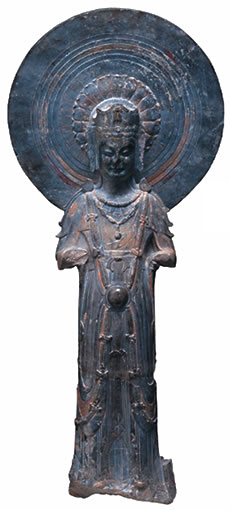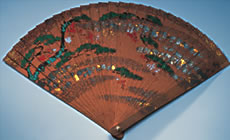| THIS SECTION OF THE 5TH
ANNIVERSARY EXHIBITION in the North Wing will display Japanese works
of art—selected from the previous special exhibitions; The Grand
Opening Exhibition, The 1st Annivarsary Exhibition, and A Tama-Tebako for
Spring Exhibition—as well as treasures from Six Dynasties and Tang
China and Korea. Beginning with early Chinese Buddhist art from the Six
Dynasties period (c. 222-589) and burial objects and silverware from the
Tang dynasty (618-c. 907), the exhibition will feature Japanese religious
and secular art. On display will be Buddhist objects, such as the Golden
Light Sutra (J., Konkômyôkyô ) in Gold Characters
on Purple Paper from the Nara period (710-793), Enmaten (s: Yama-deva)
from the Heian period (794-1185), and Bodhisattva Ksitigarbha from
the Kamakura period (1185-1333), all of which have been designated Important
Cultural Properties; sacred Shinto treasures, including the Flat Quiver
with Hôsôge Floral Design and Phoenixes in Mother-of-Pearl Inlay
(Important Cultural Property) and Cypress Fan; as well as early Tokoname
and Shigaraki ceramic ware. The following display will present calligraphic
works in the elegant cursive kana style exemplified in works such as the
Katsura edition of Man’yôshû (Collection of Ten
Thousand Leaves) and the“ Sunshô-an Shikishi”
Poem Paper, as well as Heian and Kamakura-period calligraphy, including
a Zen calligraphy by the priest Kokan Shiren (1278-1346); yamato-e examples,
including Frolicking Animals and Figures (J., Chôjû
jinbutsu giga) and Hell Scroll (J., Jigoku zôshi);
screen paintings by Kaihô Yûshô (1533-1615) and the Paulownia
Crest Curtain Screen; and Momoyama-period (1573-1615) Mino ceramic ware.
|




